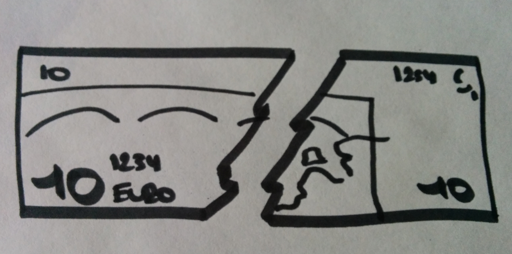Thinking No Computers
The other day I happened to see a curious exchange in one of our businesses. The cashier swapped a torn, but carefully restored by taping it together again, Euro bill for a new one with the manager. Inquisitive, I asked the manager what he was planning to do with that Euro bill. “Once a month, I take all those ripped up or badly worn bills to the National Bank, and trade them for new ones. All you need is one piece of the bank note for them to give you a newly printed one.”
While he started taking care of some other paper work, my mind started racing towards how the National Bank made this system work. I had noticed before that bank notes have an identifier on each side. I figured the National Bank probably stores the identifier of each note they trade, so people don’t go ripping up bank notes with the intent of trading them twice. That seems easy enough, no?
Once the manager finished up his paperwork, I wanted to confirm my idea and asked if he knew how that system worked. How do they avoid people cheating? “It’s really simple actually, you need to own more than 50% of a bill for it to be tradable.”
Well… that’s a much simpler solution. No need to store all the traded notes somewhere, you probably don’t even need a computer at all.
I catch myself regularly defaulting to wanting to solve problems using computers. While taking a step back and thinking of how it would be done without, often exposes a simpler model. Sometimes you will realize that you don’t need a computer at all. If not that, you get to steal from models that have been molded and battle tested for years.
Look at existing organizational structures and search for boundaries. You might find that aligning your software with existing boundaries makes the pieces of the puzzle fit. Learn how departments communicate; passing forms, by phone or by email. Maybe it shows that you need synchronous communication with strong consistency based on a formal protocol or that you might just get away with asynchronous communication with a less strong schema. Go through paper work, formulas, legislation, research papers, books and what not, and that hard to crack nut might become a bit softer. Look at where people are making decisions and how they are deciding on them, do you spot the patterns?
People have been solving problems for hundreds of years, tinkering with and perfecting models, way before computers were a commodity. Natural selection made sure only the strongest made it this far. Those solutions didn’t stop working all of a sudden, nor should they be discarded as a whole. A great deal of them will likely survive another few hundred years, in one form or the other.
